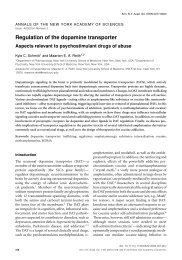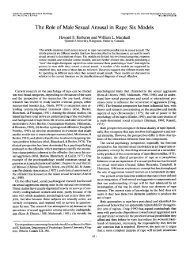Manipulation of frontal EEG asymmetry through biofeedback alters ...
Manipulation of frontal EEG asymmetry through biofeedback alters ...
Manipulation of frontal EEG asymmetry through biofeedback alters ...
Create successful ePaper yourself
Turn your PDF publications into a flip-book with our unique Google optimized e-Paper software.
Manipulating <strong>EEG</strong> <strong>asymmetry</strong> <strong>alters</strong> emotion 691<br />
Figure 4. <strong>EEG</strong> R L alpha <strong>asymmetry</strong> ~6 SE! for training responders as<br />
a function <strong>of</strong> training day. Higher numbers on the Y axis reflect greater<br />
right than left <strong>frontal</strong> alpha, and therefore putatively greater left than right<br />
<strong>frontal</strong> activity. Asterisks signify that participants trained LEFT ~open bars!<br />
differed significantly from those trained RIGHT ~shaded bars!.<br />
<strong>of</strong> emotional responses between LEFT and RIGHT responders in<br />
emotional responses prior to training, F~6,48! 0.42, ns, the<br />
pattern <strong>of</strong> emotional responses following training differed for the<br />
LEFT and RIGHT responders, F~6,48! 2.44, p .05, but p <br />
.12 following G-G correction. Planned comparisons revealed this<br />
effect was accounted for by RIGHT participants reporting significantly<br />
less, p .01, interest, amusement, and happiness than<br />
LEFT participants.<br />
EMG effects also essentially replicated. The hypothesized Direction<br />
Time Muscle-Region interaction was marginally significant,<br />
F~1,8! 4.85; p .06, but this was not moderated by a<br />
higher order four-way interaction with film type, F~2,16! .21,<br />
ns. Planned comparisons indicated that whereas RIGHT responders<br />
produced less, p .05, zygomatic ~“smile”! activity following<br />
training, LEFT responders produced less, p .05, corrugator<br />
~“frown”! activity following training; RIGHT responders demonstrated<br />
no change in corrugator activity, whereas LEFT responders<br />
demonstrated no change in zygomatic activity.<br />
Because analyzing only responders resulted in a reduction in<br />
statistical power, it is useful to consider not only statistical significance,<br />
but also the effect size ~Eta Squared!. Considering first the<br />
self-report film finding ~i.e., the interaction <strong>of</strong> Direction Emotion<br />
Day for the happy film!, the effect size for all subjects was<br />
.16 and for responders it was .35, more than twice as large.<br />
Considering the EMG finding ~Direction Time Muscle-<br />
Region interaction!, the effect size for the full sample was .30, and<br />
for responders it was .38. The consistently larger effect size among<br />
responders compared to the entire sample provides further evidence<br />
consistent with the hypothesis that manipulating <strong>frontal</strong><br />
<strong>EEG</strong> <strong>asymmetry</strong> produces changes in emotional self-report and<br />
facial expression.<br />
Discussion<br />
Extant evidence supporting the approach–withdrawal model <strong>of</strong><br />
<strong>frontal</strong> <strong>EEG</strong> <strong>asymmetry</strong> is substantial, but based largely on correlational<br />
data—that is, the correlation between resting asymmetrical<br />
activity and responses to emotionally evocative events, or between<br />
resting <strong>asymmetry</strong> and individual differences related to emotion. 4<br />
The present research was designed to extend this body <strong>of</strong> evidence<br />
by examining whether asymmetrical <strong>frontal</strong> activity caused these<br />
emotional responses. The present study must be regarded as preliminary<br />
in this regard, but supports the hypothesis that manipulation<br />
<strong>of</strong> <strong>frontal</strong> <strong>EEG</strong> <strong>asymmetry</strong>, and by inference cortical activity,<br />
<strong>alters</strong> the pattern <strong>of</strong> emotional responding consistent with predictions<br />
derived from theoretical accounts <strong>of</strong> <strong>frontal</strong> brain <strong>asymmetry</strong><br />
~e.g., Davidson, 1998; Harmon-Jones & Allen, 1997, 1998!.<br />
Although other investigations have shown that <strong>EEG</strong> alpha<br />
<strong>asymmetry</strong> changes can occur as a result <strong>of</strong> bi<strong>of</strong>eedback training<br />
~Rosenfeld et al., 1995!, and that such <strong>asymmetry</strong> changes cooccur<br />
with a reduction in depressive symptoms ~Baehr et al., 1997!, this<br />
is the first controlled investigation <strong>of</strong> the effect <strong>of</strong> such training<br />
on emotional responses. Bi<strong>of</strong>eedback training <strong>of</strong> <strong>frontal</strong> <strong>EEG</strong><br />
<strong>asymmetry</strong> produced results generally consistent with the expected<br />
pattern <strong>of</strong> emotional responses, as indicated by both selfreport<br />
and facial EMG. Consistent self-report effects emerged<br />
only when participants viewed the happy film, but not the neutral<br />
or the sad films. EMG effects emerged across all films. Neither<br />
measure should necessarily be viewed as preferable or more robust,<br />
because each measure provides a somewhat independent yet<br />
convergent index <strong>of</strong> emotional response, commensurate with the<br />
use <strong>of</strong> multiple measures advocated by Campbell and Fiske ~1959!<br />
and others.<br />
When effects were examined only among those participants<br />
who responded to bi<strong>of</strong>eedback training ~i.e., responders!, selfreport<br />
and EMG effects replicated despite a rather dramatic reduction<br />
in power, and effect sizes increased. The responder analyses<br />
addressed not whether all participants show bi<strong>of</strong>eedback effects,<br />
but rather what the effects <strong>of</strong> <strong>asymmetry</strong> manipulation are in those<br />
who show training-related changes. Responders trained LEFT and<br />
RIGHT did not differ on the first day <strong>of</strong> bi<strong>of</strong>eedback training, but<br />
did on all subsequent days. Because responders were defined by<br />
their change from their own baseline, self-report and EMG effects<br />
were not due to trait differences, but rather were due to specific<br />
changes in <strong>asymmetry</strong> across the course <strong>of</strong> training.<br />
Consistent with past research, asymmetrical <strong>frontal</strong> activity<br />
does not relate to unprovoked mood in nonclinical samples, but<br />
instead relates to emotional responding to stimuli that evoke<br />
approach- or withdrawal-related tendencies ~Davidson & Fox,<br />
1989; Harmon-Jones & Allen, 1997, 2001; Wheeler et al., 1993!.<br />
In clinical samples, asymmetrical <strong>frontal</strong> activity has <strong>of</strong>ten ~Allen<br />
et al., 1993; Gotlib et al., 1998; Henriques & Davidson, 1990,<br />
1991; Wiedemann et al., 1999! but not ubiquitously ~Reid et al.,<br />
1998! been found to related to unprovoked mood, but such a<br />
relationship has repeatedly not been found in nonclinical college<br />
student samples ~Harmon-Jones & Allen, 1997; Sutton & Davidson,<br />
1997; Wheeler et al., 1993!. In normative samples ~college<br />
students and infants; e.g., Davidson & Fox, 1989; Wheeler et al.,<br />
1993!, it has consistently been the case that preexisting differences<br />
in <strong>frontal</strong> <strong>asymmetry</strong> are manifest in behavior only when the<br />
appropriate emotion-eliciting situation arises.<br />
4 Some studies in support <strong>of</strong> the approach–withdrawal model have<br />
measured state-dependent changes in <strong>frontal</strong> <strong>asymmetry</strong> in response to<br />
manipulations designed to elicit emotions @e.g., films ~Davidson, Ekman,<br />
Saron, Senulis, & Friesen, 1990!, an insult ~Harmon-Jones & Sigelman, in<br />
press!, and maternal separation in infants ~Fox & Davidson, 1987!. Such a<br />
design, in which <strong>frontal</strong> <strong>EEG</strong> is a dependent variable, does not directly<br />
address the central issue <strong>of</strong> the present study, namely whether resting <strong>EEG</strong><br />
<strong>asymmetry</strong> can cause emotional responses.










